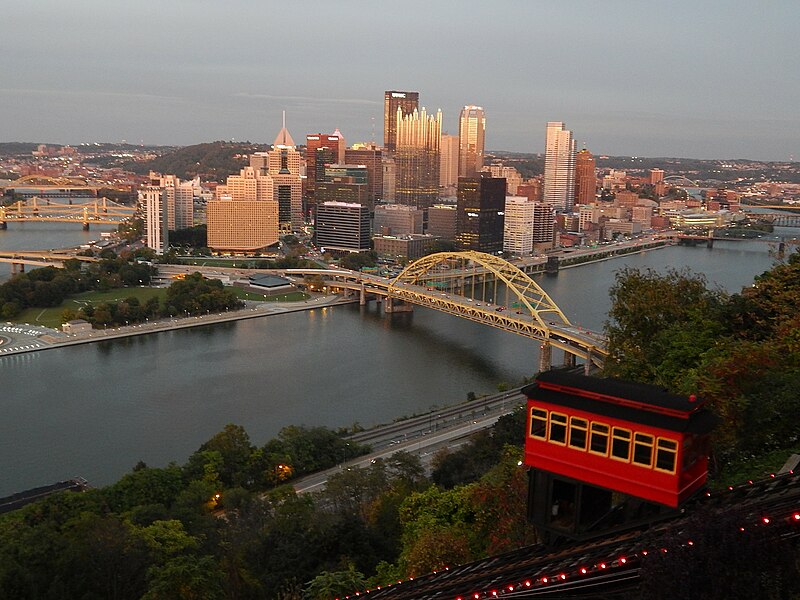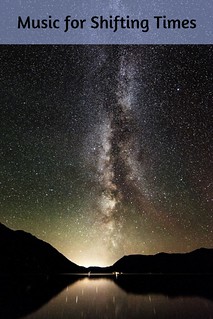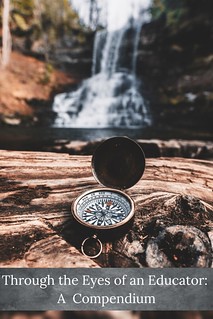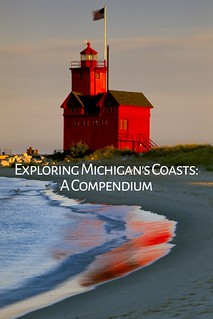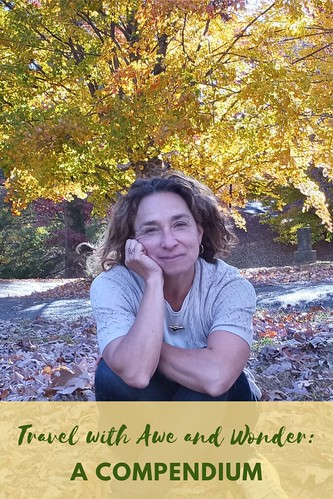Exploring Pittsburgh Series
Pittsburgh is one of my favorite cities in the world, and as someone who has traveled to 14 countries (and counting!), I can really say that with gusto! From living in different cities like Miami, Florida; Charleston, South Carolina; Kalamazoo, Michigan; and Rome, Italy, I can say that I have a sincere appreciation for the Iron City that I never had before. I’m a native Pittsburgher and proud of it - and that’s how the Exploring Pittsburgh Series was born. After I took a great job at the University of Pittsburgh in 2014 and my husband, Fernando, and I moved back to the area, we took to exploring this wonderful place as if for the first time and we are sharing our adventures with all of you! Pittsburgh also is a very special place for my husband and I: we met here in 2007; got engaged on Mt. Washington in 2009; got married here in the lovely fall of 2011; and then moved for our jobs here in 2014—and we plan on never leaving again. The revolution that Pittsburgh is undergoing with continued growth and prosperity is incredible to watch, and we look forward to raising our family here in this unique and amazing place in southwestern Pennsylvania.
Pittsburgh skyline. Wikimedia Commons: Robpinion
The city has been named by Condé Nast Traveler as one of the “Top 15 Places to Go in 2015!” Pittsburgh is ranked among the top places to live, work, and visit in the United States. It’s consistently recognized as one of the most livable cities with one of the most viable economies. Travel Channel ranked Pittsburgh as the 2014 Best All-American Vacation, stating:
"Pittsburgh is home to more than 39 colleges and universities and is bubbling over with young people helping to redefine the city. The Steel City has even become an arts destination thanks to institutions such as the iconic Andy Warhol Museum, as well as the Mattress Factory, a contemporary art museum with room-sized installations spread throughout a 4-story warehouse. It's not only one of the hippest cities in America, but also it's located in the great expanse of western Pennsylvania. Spend the day in town at the Carnegie Museums, then head south to Frank Lloyd Wright's Fallingwater to see an architectural wonder or to Ohiopyle State Park for thrilling whitewater."
USA Today put Pittsburgh on the list of America’s Most Stunning Views, saying: “the panoramic view of downtown atop Mount Washington has long been considered one of the best skyline views in the world.” [side note: my dear husband Fernando asked me to marry him here and I can attest to how incredibly gorgeous the skyline really is!]

Mt Washington Overlook. Photo Stasia Lopez
No matter if it’s for our world-renowned hospitals or one of our 40 higher education institutions in the area, Pittsburgh is a place for young and old alike, and our rankings continue to grow every year. It’s a city that has so much to offer, both within the city proper and the charming suburbs.
Wikimedia Commons: Gibbyboy15
A City of Firsts
Some may or may not know some of these incredible facts of many “firsts”, here in Pittsburgh. Take a look at a few:
• Home to the first Ferris Wheel in 1893
• First Polio Vaccine in 1954
• World’s first Commercial Radio Station (KDKA)
• First U.S. Public Television Station in 1954 (WQED)
• First nighttime World Series game in 1971
• First Internet emoticon, the smiley, in 1982 at Carnegie Mellon University

Wikimedia Commons: Btezra
The Arts
Pittsburgh has also been called the “Hollywood of the East,” because of the growing film industry happening right here in our city and many towns and neighborhoods. More than 50 films have been shot on location in the area, including The Perks of Being a Wallflower, The Dark Knight Rises, Out of the Furnace, Inspector Gadget, The Silence of the Lambs, Love and Other Drugs, and The Fault in Our Stars.
Our city has many talented dancers, choreographers, vocalists, actors, writers, and musicians, including: Gene Kelly, Michael Keaton, Jeff Goldblum, Christina Aguilera, Lena Horne, George Benson, Annie Dillard, The Vogues, Rusted Root, Dan Marino, Joe Montana, and Tony Dorsett. All are famous Pittsburghers.
The beloved icon Fred Rogers was a native from Latrobe, 40 miles east of Pittsburgh, and famous for the popular children’s television show, Mister Rogers’ Neighborhood. He was also an ordained Presbyterian minister. In 1966, Mr. Rogers and his wife and two sons returned to Pittsburgh, where the Public Broadcasting Service (PBS) would incorporate the series. In 1998, the Children’s Museum, along with Fred Rogers and his company, Family Communications, created the Mister Rogers’ Neighborhood exhibit. It welcomed thousands of visitors each year and a sister exhibit traveled for eight years to other museums across the country. His sweaters and tennis shoes and other items from the “land of make believe” that captivated audiences for so many years can now be found at the Children’s Museum in Pittsburgh.

Christmas in Pittsburgh. Flickr cc: jiuguangw
Food
Pittsburgh’s famous foods have made the map for foodies and anyone can find something they enjoy here to satisfy the hunger pangs for any visitor or native alike. The McDonald’s Big Mac was invented here and if you ask any Pittsburgher what kind of ketchup they prefer, without question, it had better be Heinz [we can taste a big difference compared to other ketchups!].
With strong Polish and Ukrainian heritages in the area, you can easily find many churches selling homemade pierogies, especially during Lent, as well as Paczki [donuts] that are filled with fruit fillings, custards, and crèmes and served starting on Fat Tuesday or Mardi Gras. They are the most delightful and savory donuts I’ve ever had, and the amazing churches in and around Pittsburgh host many homemade treats from Paczkis before Lent and selling and serving pierogies and fish fry throughout Lent. I never realized how unique this was until I lived in other places, but many people look forward to this is annual tradition.
Going to the deli was something I remember doing since I was a little girl. Getting all the lunchmeat a family would need for the week was a traditional thing to do, and chipped ham is another famous Pittsburgh food that is a hometown favorite.
Italian Wedding Soup is a traditional soup with tiny meatballs, shredded chicken, and tiny pasta in a delicious chicken broth that’s served throughout the city as well as at, of course, weddings!
The Primanti Bros. Sandwich is a Pittsburgh favorite made with your choice of meats, veggies, and served also with coleslaw and fries right in the sandwich itself—it was invented during the Depression for laborers to hold their entire lunch in one hand. If you enjoy salads, don’t be surprised to see fries on top of your salad, either! Whenever we get a visitor coming from out of town, we always take them to Primanti Bros. because it’s truly “a Pittsburgh thing!”
Pittsburgh has many diverse, cultures from all over the world, including Greek, Italian, Russian, Ukrainian, Polish, Jewish, Serbian, Irish, Asian (particularly Chinese, Japanese, and Indian), Hispanic, Native American, and African American, just to name a few! Many of these ethnic groups hold festivals and events throughout the year to celebrate their beautiful cultures.
Lastly, if you’re in the mood for a cold, yummy treat, the Klondike Bar is another Pittsburgh-made original that keeps getting better with age for its many new flavors. In 1929, they cost a nickel for the vanilla ice cream bar dipped in chocolate; they are still packaged in the recognizable silver wrapper.
Pittsburghese
Pittsburghese is a unique accent infusing the early Scottish-Irish settlers’ dialect with the Midland dialect in Southwestern Pennsylvania. Pittsburghers enjoy talking and promoting examples of Pittsburghese on postcards, t-shirts, and even on Pittsburgh Dad, a YouTube series of hilarious videos talking in the Pittsburghese accent with scenarios of life found only in our city. Some common words that are pretty disguishable at first auditory glance are: yinz (you ones), Stillers (Steelers), dahntahn (downtown), and n’at (and that). There are many, many more words and sounds used in this linguistic phenomenon that have even inspired scholars of linguistics to study it further. Growing up, we always called the vacuum cleaner, “running the sweeper.” I don’t know if that’s necessarily Pittsburghese or not, but I can say from the different cities that I’ve lived in, no one understood what I was talking about until I had to explain it. My poor husband, whose native language isn’t English, is trying to hang on and understand the different words of Pittsburgh and refers to them as slang, “because it doesn’t sound like English.” He felt better when I told him that although unique to the area, Pittsburghese was voted America’s ugliest accent. Love it or hate it, it’s a Pittsburgh thang! ;)
Nicknames
Let me first tell you some of the cool nicknames that Pittsburgh has and how the city got some of its namesakes:
City of Bridges
Pittsburgh is situated among three glorious rivers: the Allegheny, the Monongahela, and the Ohio [hence the use of “three rivers” in some of its names and establishments]. With the many hills, deep valleys, and rivers to cross, the residents here cross every kind of bridge except a drawbridge and there’s an estimated 2,000 bridges in the ‘Burgh [which is a lot more than Venice, Italy!].

Wikimedia Commons: mihir samel
Steel City
The city’s industrial heritage of steel [and glass] made it a hub for coal mining and steel production. Two distinct men, Andrew Carnegie and Henry Clay Frick, played an integral role in forming the United States Steel Corp. Because of so many devastating train derailments from wearing iron train rails, Carnegie opened the Edgar Thomson Works at Braddock in 1875, which introduced high-volume steel for a low cost to the Pittsburgh region. Carnegie manufactured Bessemer steel rails from England. When Frick’s coke mining company merged with Carnegie, the steel mills moved into the river towns of Homestead, Duquesne, Aliquippa, Ambridge, and Monessen. The city became the Arsenal of Democracy, providing over 95 million tons of steel, aluminum, munitions, and machinery for the U.S. and the Allies during World War II. Pittsburgh has a long and embedded history with steel, and as you look around at the many bridges, railroads, and skyscrapers, the use of steel continues to be a staple of the culture of the city.
City of Champions
With three major professional sports teams in the area [the Pittsburgh Steelers (football), the Pittsburgh Penguins (hockey), and the Pittsburgh Pirates (baseball)]—it’s easy to see why Pittsburgh is called the City of Champions after all the amazing accomplishments each of the teams have achieved. The Steelers played in eight Super Bowls and have won six of them [years: 1975, 1976, 1979, 1980, 2006, 2009]; the Pittsburgh Pirates have won five World Series games [1909, 1925, 1960, 1971, 1979]; the Pittsburgh Penguins have won three Stanley Cups [1991, 1992, 2009].
The ‘Burgh
Pittsburgh is one city in the U.S. that has an ‘h’ at the end of its name. In over 20 other cities and towns in Maine, New Hampshire, Kansas, Illinois, Texas, and California, other cities with the same name do not have the ‘h’ .
The Golden Triangle
Where the Allegheny and Monongahela rivers come together and merge to form the Ohio River is known as the Golden Triangle. Point State Park, located at the tip of all three rivers, commemorates and preserves the historic heritage during the French and Indian War [1754-1763]. Visitors can walk along the riverfront viewing the lovely landscape of the city with its scenic hillsides, many bridges, and waterways, as well as the 100-foot tall fountain with geyser-like water flowing out of it. The three rivers were named by Native American tribes that lived in the area: Menaungehilla, which means “high banks breaking off and falling down at places;” the Alligewihanna, meaning “stream of the Alligewi;” and Ohi-io by the Seneca tribes, meaning “River beautiful.”
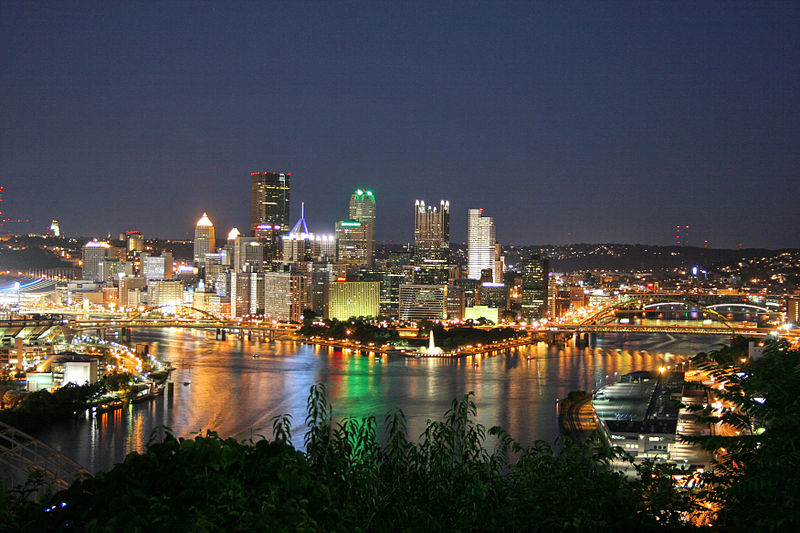
Pittsburgh at night. Wikimedia commons: Ronald C. Yochum Jr.
History and Personality
The Underground Railroad is one of the most significant forms of activism in our nation’s history, and encompassed the United States and beyond. Pittsburgh has several iconic locations where many slaves sought freedom. Visitors can explore over 250 years of African-American history in the Senator John Heinz History Center’s exhibition, From Slavery to Freedom, highlighting the anti-slavery movement, the Underground Railroad, and the impact of 19th century activism and civil rights in Pittsburgh.
Pittsburgh’s 90 charming and unique neighborhoods each have a distinct personality. The Strip District is an eclectic shopping spot with a lot of diverse food options; Lawrenceville is an artsy neighborhood; Shadyside is a great, upscale, shopping area; Oakland is an intellectual and cultural outlet with many universities and museums; East Liberty is very entrepreneurial; Bloomfield is called “Pittsburgh’s Little Italy!” The South Side is a fun nightlife spot; the North Side/North Shore areas have many family-friendly destinations and sporting events; Sewickley [where I was born!], is another upscale neighborhood with tree-lined streets and cafes; Mt. Washington has the best view in the city [as well as the one of the best in the country and the world!], and Downtown is the Cultural District with many theatres to watch plays, operas, ballets, orchestras, and others, public art galleries, extraordinary dining, parks, plazas, and more shopping options!
Pittsburgh has it all: annual events and festivals, casinos and gaming, family-friendly options, world-renowned hospitals and universities, performing and visual arts, movies and film [including drive-in movie theatres!], incredible shopping, fun amusement parks, zoos, science centers, and more. I could not have picked a better place to live and one day, raise my own family here. It is a diverse, unique city with so much to offer. Fernando and I look forward to visiting other places around the Pittsburgh area to give Wandering Educators’ readers an inside look at Pittsburgh. It is not only a place that we’re so thankful and proud to live in, but it is also our home.
Check back for more articles in the Pittsburgh Series - we look forward to showcasing one of the most incredible and transformative cities in the world!

Duquesne Incline. Flickr cc: bobistraveling
Explore Pittsburgh Series:
Exploring Pittsburgh: Phipps Conservatory and Botanical Gardens
Conservation and Education at the Pittsburgh Zoo and PPG Aquarium
Exploring Pittsburgh: Carnegie Museum of Natural History
A Guide to Exploring the Carnegie Science Center
More Pittsburgh Resources:
http://www.wqed.org/education/pghist/units/WPAhist/wpa5.php
http://www.heinzhistorycenter.org/exhibits/city-of-champions
http://cityofchampionssports.com/
http://www.popularpittsburgh.com/pittsburgh-info/pittsburgh-history/whatsinanh.aspx
http://www.dcnr.state.pa.us/stateparks/findapark/point/
http://www.visitpittsburgh.com/about-pittsburgh/underground-railroad/
http://www.coolpgh.pitt.edu/eating/pittsburgh-culture.php
http://www.pbs.org/speak/seatosea/americanvarieties/pittsburghese/
Stasia Lopez is the Global Education Editor for Wandering Educators and is also a Career Consultant at the University of Pittsburgh. She graduated with her Master’s degree in Educational Leadership in Higher Education and Student Affairs from Western Michigan University and earned her Bachelor of Science in Business Administration degree in Hospitality and Tourism Management from Robert Morris University. Stasia is passionate about international education, travel, and loves working on a college campus. She’s lived in four different U.S. states (Florida, Michigan, South Carolina, and Pennsylvania) and also studied and lived abroad in Rome, Italy. Stasia lives in the Pittsburgh area with her husband, Fernando, precious daughter, Maya, and playful kitty-cat Zorro.



